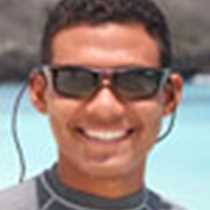Today, the National Geographic Endeavour visited two different locales, each with very different stories to tell.
In the morning, we visited North Seymour Island. Located almost in the middle of the archipelago, North Seymour is an important stop for many bird species. This area was once underwater but geological activity has lifted it above sea level. The island is often used as a resting and nesting area for seabirds that often travel long distances to find food. Perched on trees were several male frigatebirds with their massive gular pouches inflated to attract females flying by.
The abundance of food at this time of year meant that blue-footed boobies were also breeding. We observed some males performing their characteristic one-two step courtship dance. Other blue-footed boobies fed on fish or took care of chicks. On our hike we also found some large land iguanas and sea lions.
In the afternoon, we moved on to Rabida Island, where we explored the spectacular shoreline on kayaks. Some of us went snorkeling, the first such opportunity of the voyage, and encountered many tropical fish, sea turtles and penguins. Other guests enjoyed relaxing on the red-sand beach in the company of sea lions. The beach’s unique color is due to oxidized iron in the sand.
As the day ended, we all gathered on the beach for a sunset stroll. It was the second day of our voyage around the famous Galapagos Islands and we couldn’t wait to see what was coming next.




